If you’ve been reading this blog for any length of time you’ve doubtlessly noticed that with the exception of Steve Tracy’s recent article, I haven’t given Ruger much love. That changes today! After Mike and I visited the Ruger factory in Prescott, we were generously offered access to T&E samples of Ruger revolvers – an offer we wasted no time taking them up on. The first gun I wanted to get my hands on is the one reviewed here: the GP100 Match Champion.
I know we’re late to the party – there are tons of reviews covering the GP100 Match Champion that already have a little dust on them. What I hope to offer is a review from someone who runs wheelguns on a daily basis as a primary defensive handgun, and for that matter, his only handguns. Not that this makes me an expert or any better judge of a gun’s worth than anyone else, but I do think it gives me a unique perspective on the matter. In reviewing this gun I’ll probably contradict some of those other reviews out there. Not purposefully, mind you – I’m just going to call this one like I see it.
First Impressions
Opening the grey Ruger box revealed a fine-looking revolver, a lock, disassembly pin, and the instruction manual. After getting a few intial photographs, I pulled out the chunky gun and began getting familiar with it. My first impression of the revolver is that it is made to a reasonably high standard. Now you might be thinking, “Justin, it’s a revolver from a well-established manufacturer – of course it’s made to a decent standard!” Unfortunately I’ve had the opportunity to handle the new Colt Cobra and some Smiths of recent vintage. The finish on these guns seems to be trending toward a cheap-looking bead blast that looks more at home on a bargain-basement blaster than on products supposedly produced by leaders in the industry*. And quality control (especially on revolvers for some reason) seems to be a remnant of a bygone era.
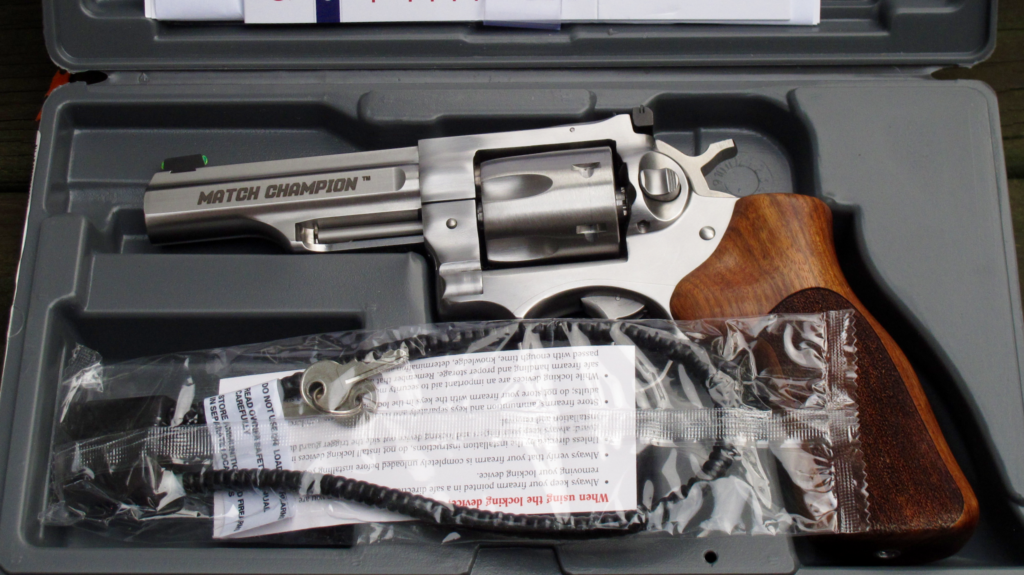
Not so with the Ruger, or at least it doesn’t scream “cheapness.” This gun is stainless steel and proud of it. The fit, finish, and overall quality of the GP100 Match Champion seemed to be outstanding and free of much of the corner-cutting that is becoming industry standard. Working with the GP100 Match Champion over the next several weeks would prove to me that this gun is far from perfect, but it mostly lived up to my initial expectations. I’ll talk about what I found – good and bad – and give you my verdict at the end.
Trigger
One of the first things I am interested in with a new gun is the trigger, and this trigger was initially pretty atrocious. Admittedly I am a little spoiled with revolver triggers, so this one took some getting used to. The bang-switch on the GP100 Match Champion is close to a pound and a half heavier than anything I own, coming in right around 12 lbs. Aside from being heavy, the trigger also had some pretty horrendous grit and hitches, at least initially. The pull would be fairly smooth for the first two-thirds of its travel, then hit another wall concurrent with cylinder lockup.
“I know how to fix that,” I thought, and immediately dropped in a set of A-Zoom Snap Caps. I got serious about dry firing it. After a few hundred dry-reps over over several days, the trigger pull began to smooth significantly. I also began to notice some visible wear on both the trigger and hammer as exhibited in the photo below. It seems that the parts needed to wear in together, and this contributed to smoothing the lockwork substantially. A carefully placed drop of CLP here and there didn’t hurt none, either, and soon enough the trigger actually felt pretty good.
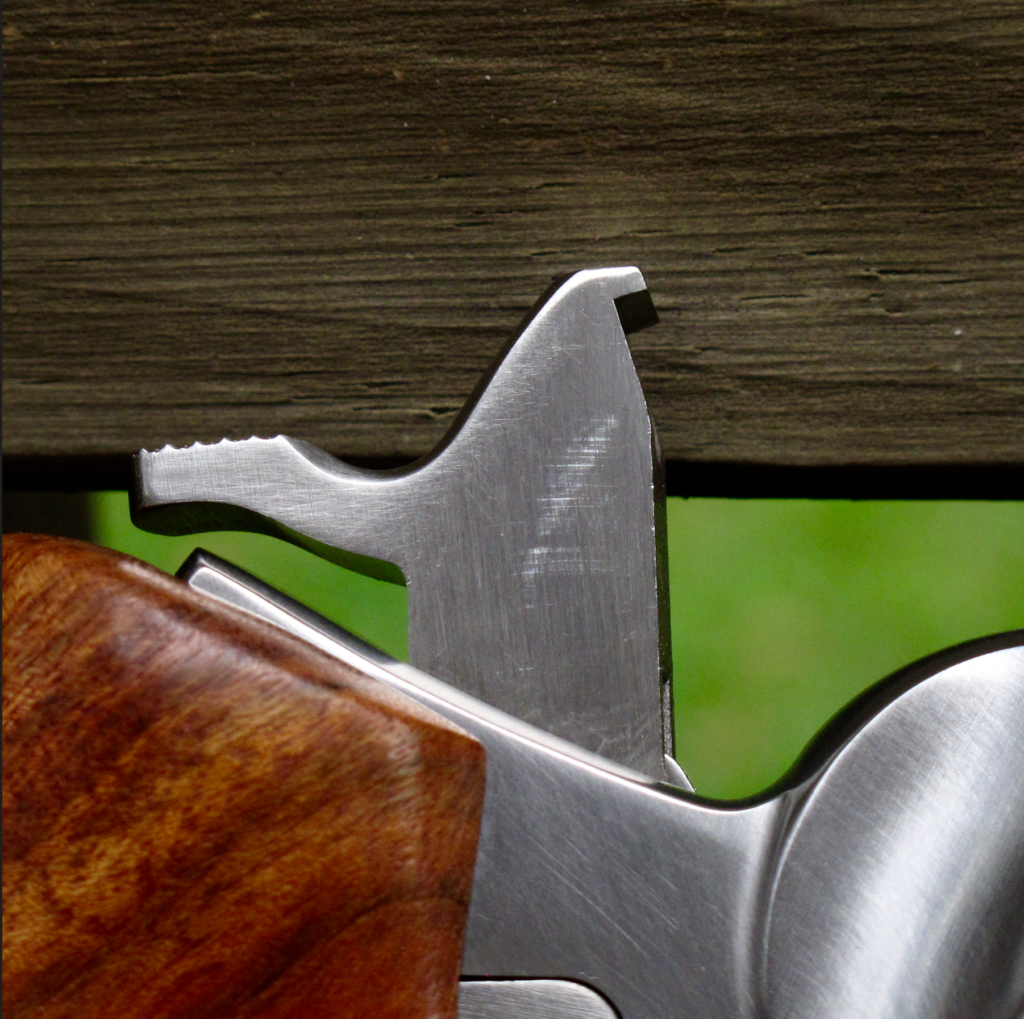
The single-action pull never got great, but here’s the thing: I’m being really, really snobby about it. That is to say, I am judging it against an unrealistically high standard that is probably meaningless in the real world. However, I will tell you what I felt. On this exemplar there was a very small, slightly distracting amount of creep before hitting the “wall” of the SA trigger. Realistically speaking this is an extremely slight amount of superfluous travel and I rarely use the single-action function on my revolvers (including this one), reserving it only for long shots of let’s say, 50 yards and greater. I do prefer to keep the single-action capability on revolvers that might be carried in the woods or desert for these longer shots, but I doubt this bit of trigger creep would make a huge difference one way or the other in those environs. Still, it’s worth mentioning in case you’re looking for a target gun or long-range hunting handgun.
Sights
The GP100 Match Champion sports a fiber-optic front mated to an adjustable rear sight. I’m not a fan of fiber-optics and this gun didn’t change my opinion on that. The front sight is fantastic for pushing speed but something less-than-fantastic for precision work. I found that the large, melted green dot obscures the square of the front sight, especially in bright sunlight. Lining up the sights for a precision shot felt like attempting the center a round peg in a square hole. With the fragility inherent in the fiber-optic rod itself, I applaud Ruger’s shrouded design, but I’d still rather see a tritium or gold-bead front – or at least a more refined fiber optic design.
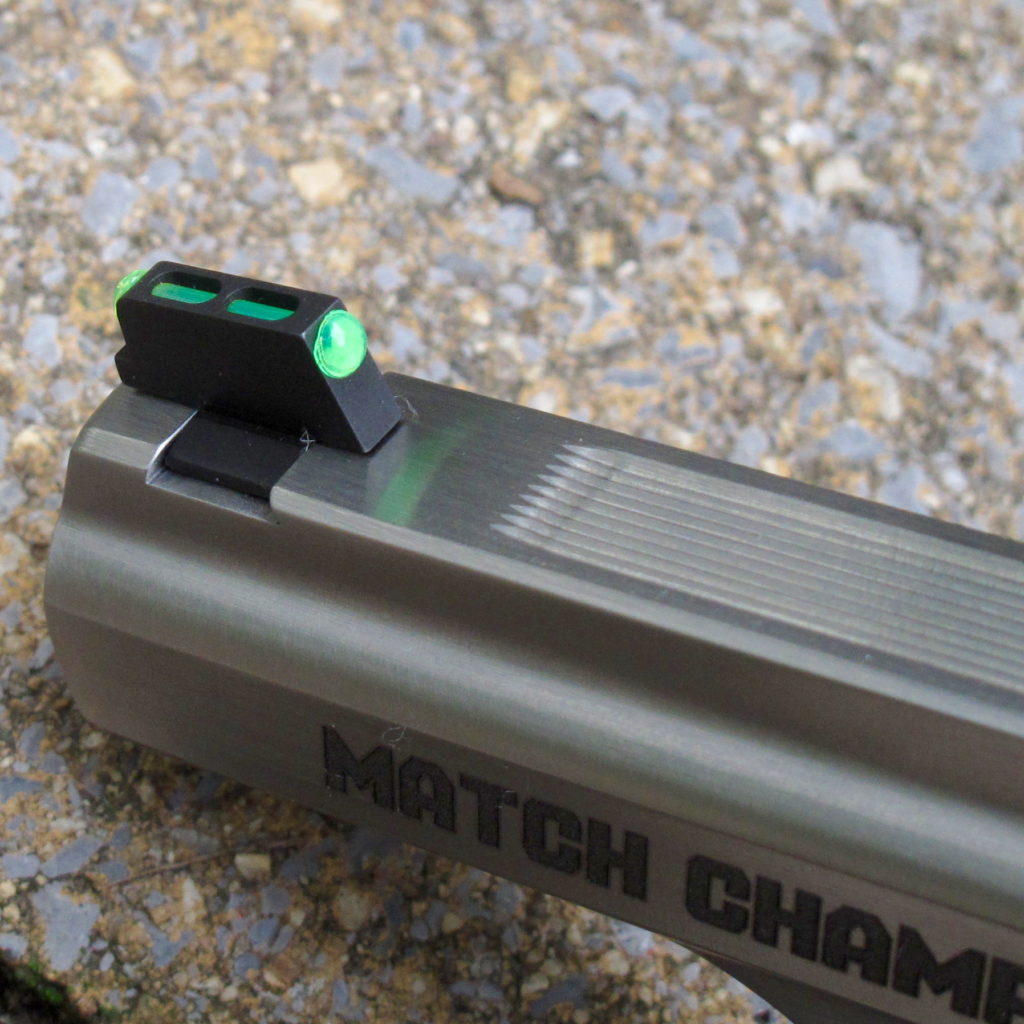
Out of the box the gun printed about 4″ high at 10 yards. This was no issue at all with the excellent adjustable rear sight. This set can be maniuplated for both windage and elevation through two set screws. Getting the gun printing on target was quick and painless. The rear sight blade has a white outline and the notch is of an ideal depth for me. Best of all, the sight is recessed well into the receiver, lessening any concerns about it being knocked out of alignment or broken during hard use. The GP100 Match Champion is also available with a fixed Novak rear sight, but I was glad to have the movable option.
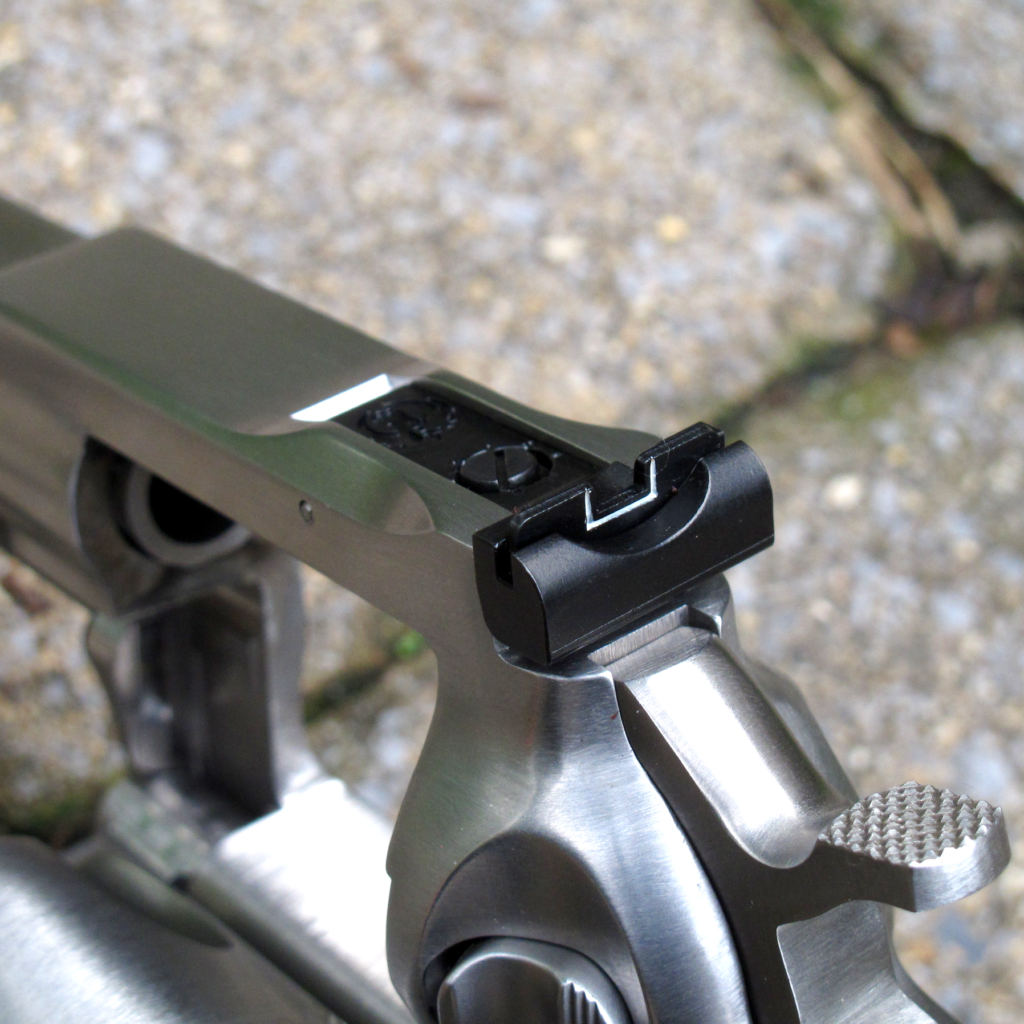
My complaint about the rear sight: the assembly is pinned rather than screwed onto the gun. After the first 100 rounds fired, the pin began to walk itself out. It had come out to an shocking extent (roughly 1/8″) by the time I noticed it. Checking the position of this pin 100 rounds or so became a ritual throughout the remainder of my shooting with GP. Sometimes it needed to be pounded back in, and sometimes it didn’t, but it never ceased to nag at me; a revolver isn’t much good if the rear sight falls off.
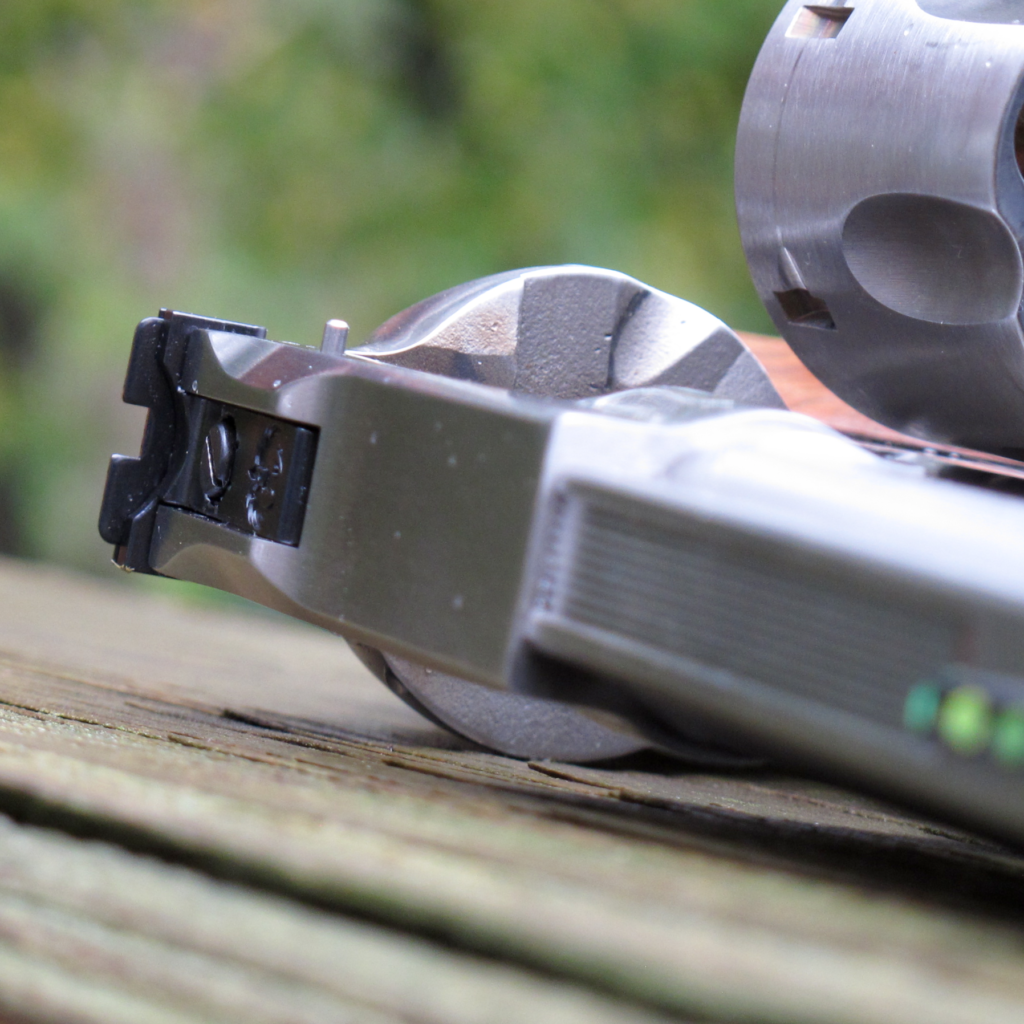
Grips
The grips on the GP100 Match Champion are very visually distinctive. Intially I wasn’t the biggest fan of their aesthetics and preferred the old rubber-with-rosewood-insert models. This was before I handled the gun significantly. After my first range session I reached the conclusion that these grips are excellent! First, the angle: it is very vertical and straight in comparison to most revolvers. If not for the subtle contouring of these wooden stocks you could almost close your eyes and imagine yourself holding a 1911.
This 1911-ish angle was evident when I first began running this revolver. If I closed my eyes and presented the gun, I would open them to find the front sight nowhere in attendance. My familiarity with more traditional revolver stocks had me pressing the muzzle down far too low upon presentation of the firearm. This was remedied in short order (again, with some dry practice) and had been more or less fully resolved by the first time I got the Ruger out to the range.
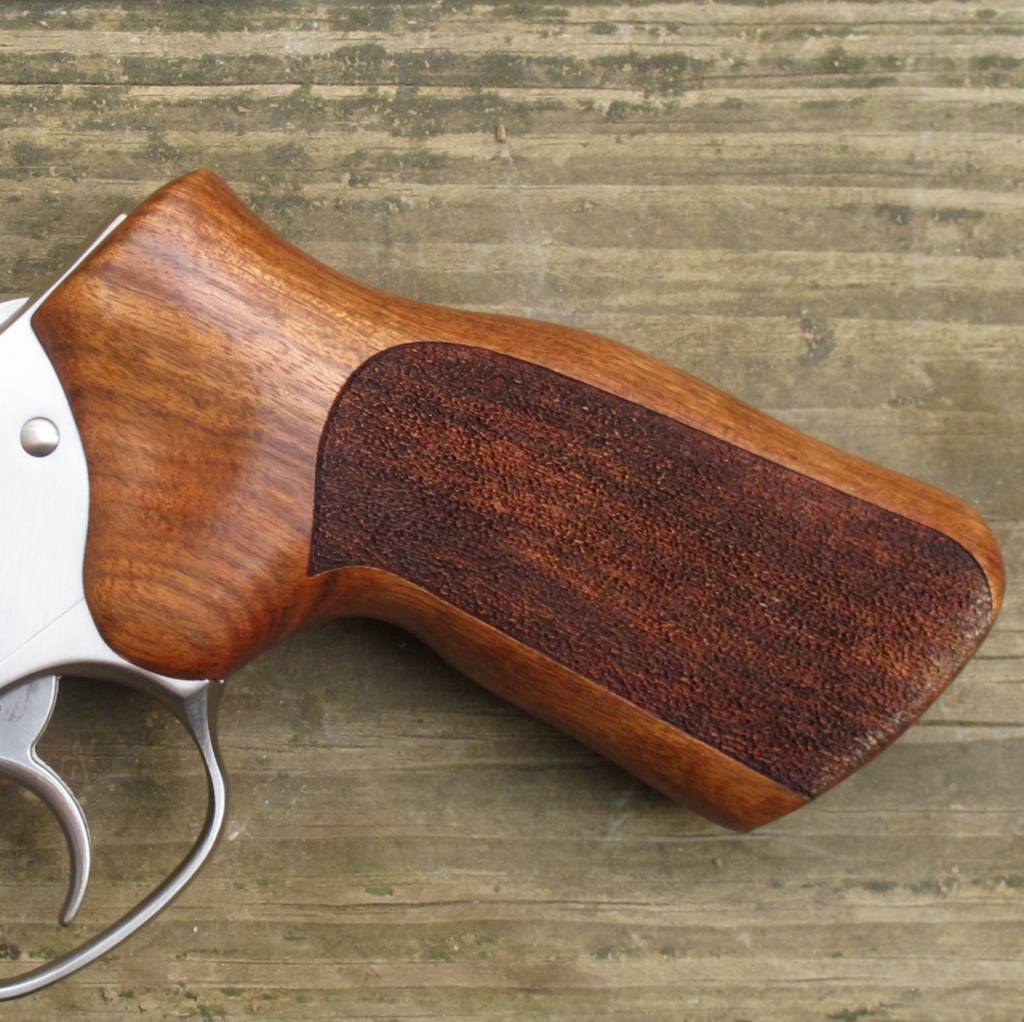
The stippling is also a very nice touch, and not just for looks. I generally avoid wooden revolver stocks because diamond-checkering tends to wear and loose its bite pretty quickly. Smooth wooden stocks just don’t quite give me enough friction, and I feel that the gun can slide around in my hand too much. The stippling on these grips splits that difference nicely. It offers outstanding purchase (I never wanted for more) and I doubt they will lose their “grippiness” much over time. Despite their atypical appearance, Ruger has done something right with these grips and I’d like to see them available for more revolvers.
If I have one complaint about the furniture on the GP100 Match Champion it would be the length of the stocks. They make the gun big. If it is to be used for home defense, hunting, competition (all venues where the handgun would doubtlessly perform well) this isn’t a concern. If you fancy concealing the GP100 Match Champion, this will be an issue. And with my small-to-medium-sized hands the extra length was wasted on me and I would have preferred a more compact overall package.
Cylinder, Barrel, and Frame
The GP100 Match Champion’s cylinder is visually interesting. If you look at it directly, you notice that the flutes are curved, making them look ovoid and frankly, a bit odd. This is due to the narrower front end of the cylinder, which is intended to ease the transition of the width of the cylinder into a leather holster. On many revolvers I would chalk this up mostly to aesthetics; on the GP100 Match Champion I think this might actually be a worthwhile feature. Because of the versatility of this handgun, it may be used for competition, home-defense, carry on the street or afield, as a hunting or competition piece, or all-of-the-above, by the same person. In Kydex this contouring won’t make much difference, but this gun might actually see some time in leather.
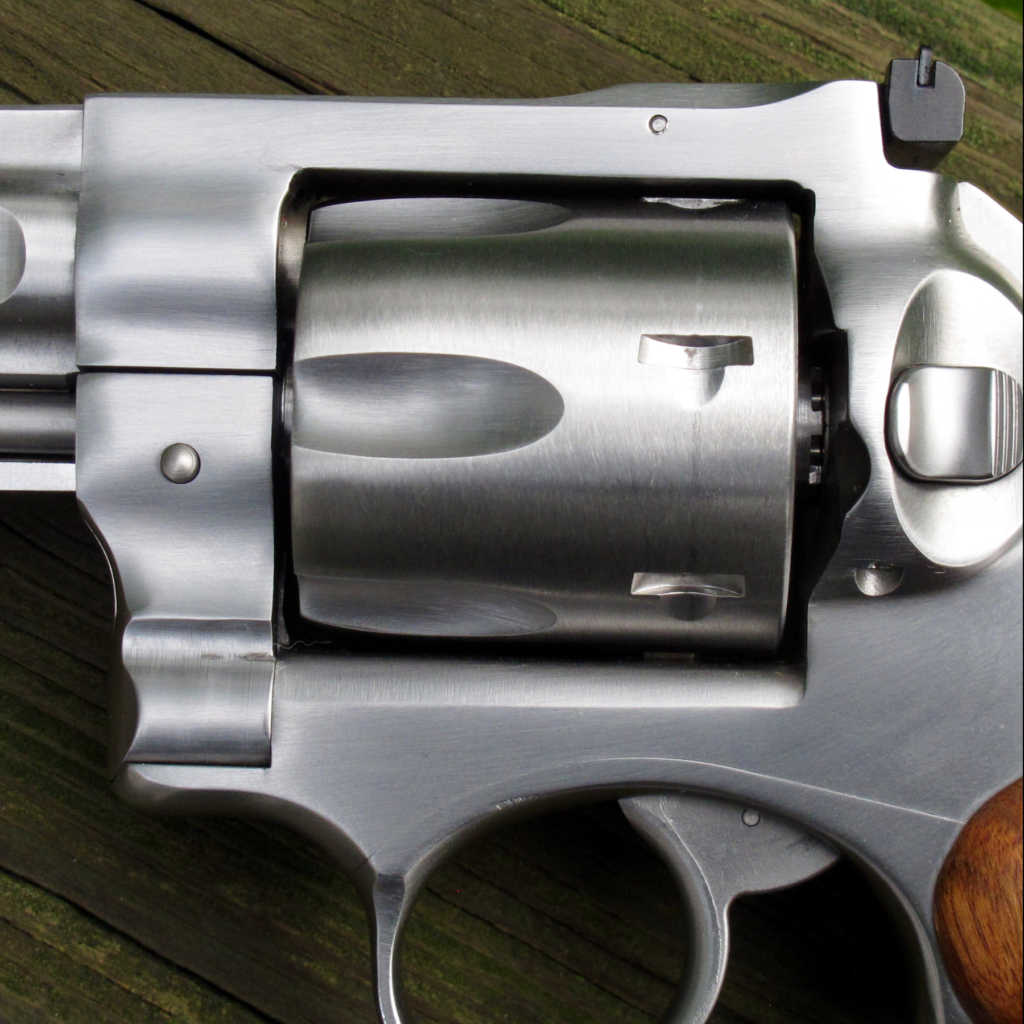
The other neat thing about the cylinder, and one that you will doubtlessly appreciate if you spend any time at all practicing reloading your wheelgun: the chambers are chamfered. The 90-degree angle on each chamber wall is only slightly broken to allow rounds to find their mark more easily. You can see this subtle angle in the photo below. This might not seem like it would make much of a difference, but it does, and I wish all revolvers came from the factory with this finishing touch.
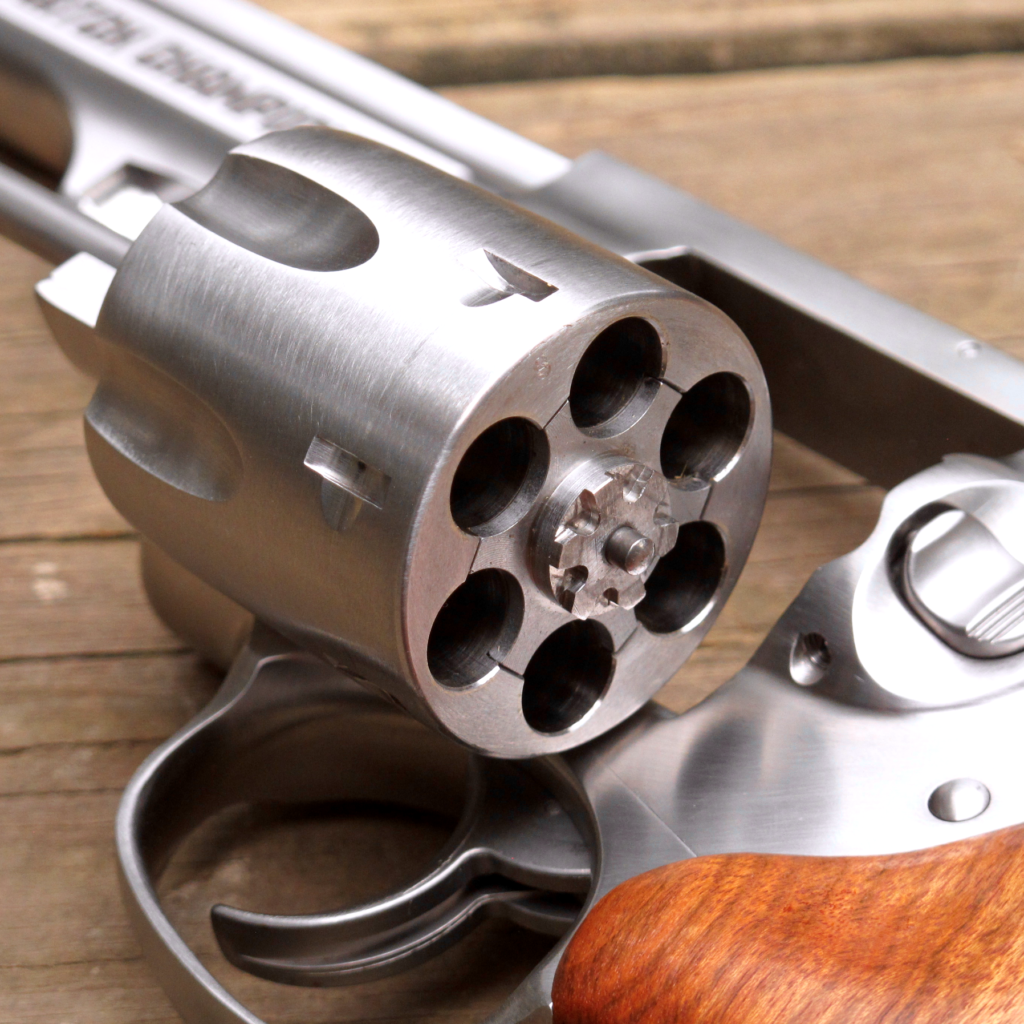
The barrel is another highly distinctive feature of this gun. In a most unusual move, Ruger decided to grace the Match Champion with a slab-sided barrel. Practically I don’t think this does a whole lot, but it sure makes the gun unmistakeable, as does the large “MATCH CHAMPION” emblazoned down the left side of the tube, and the “RUGER GP100” down the right. Thankfully, Ruger chose to provide the ubiquitious owner’s manual disclaimer in a discrete location under the ejector rod shroud. The high-visibility branding marks are touches I can live with, but could also live without.
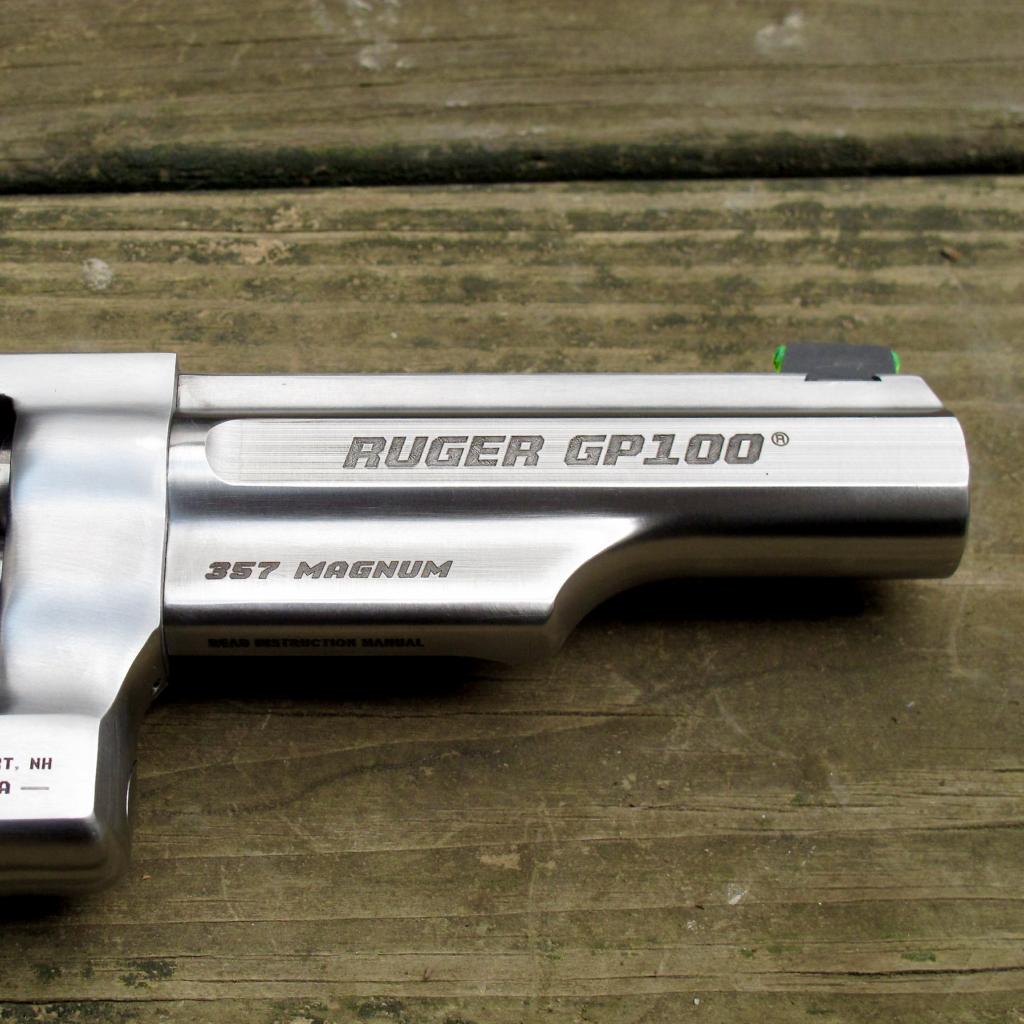
The top of the barrel is adorned with nine sharply cut lines to reduce glare. The muzzle crown is also well recessed. Neither of these features are strictly necessary, but both are appreciated by me. Another feature that I really got used to is Ruger’s cylinder release latch. It’s no secret that I am a (pre-lock) Smith & Wesson guy, through-and-through. I have trained with that latch system so much that initially I missed it a little.
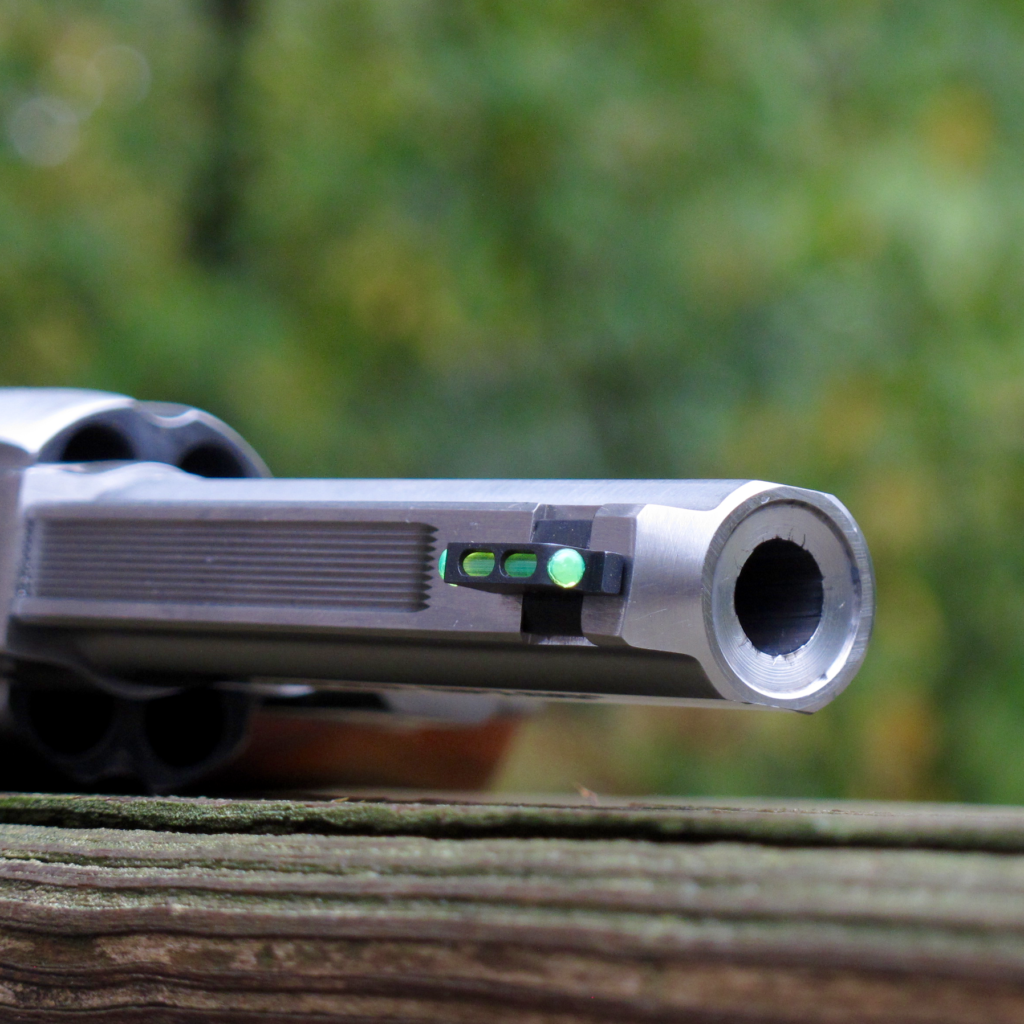
I’ve shot Rugers before but it took shooting one a lot (and dry-firing it a lot more) to really get comfortable with the latch. And pretty soon…I started to love it. The motion to unlock the cylinder began to feel natural. At the end of this test I actually feel that this is a more positive motion that is less prone to the thumb slipping off than the S&W-type latch.
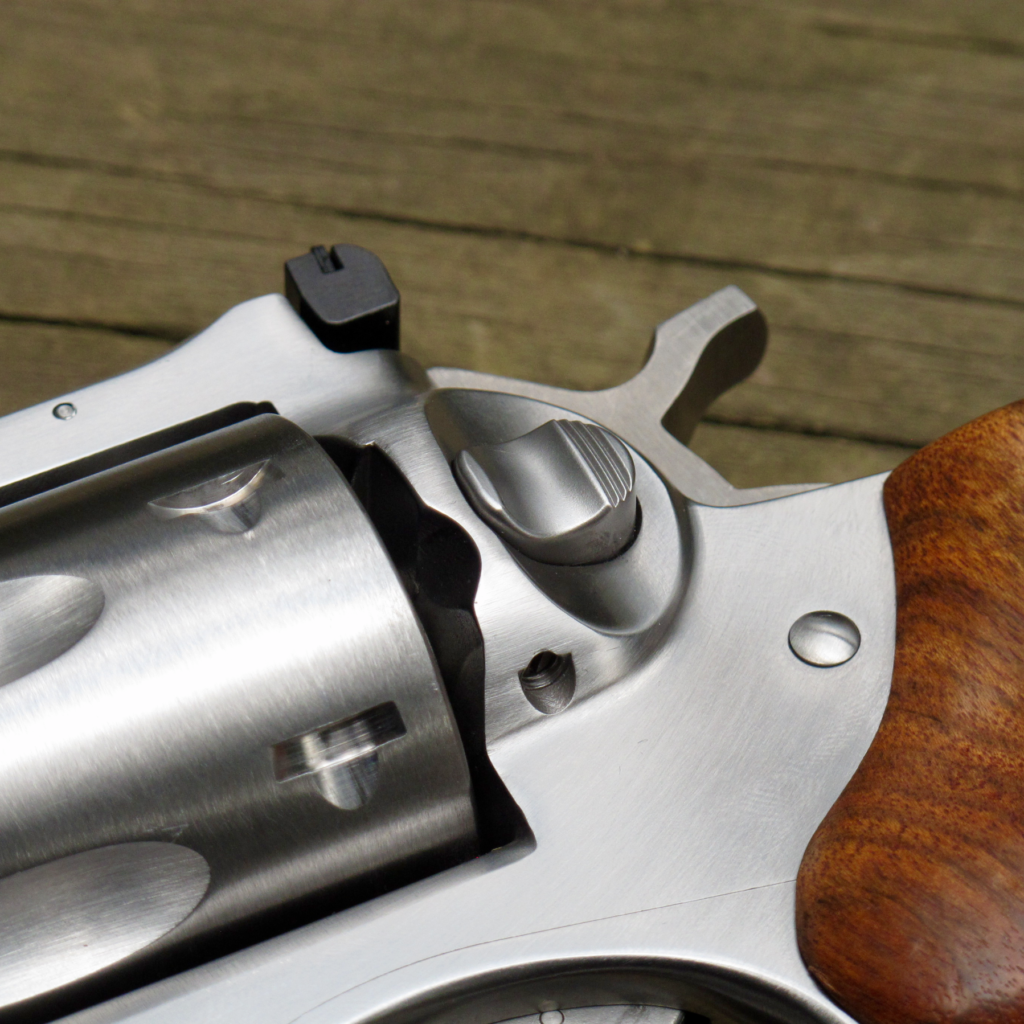
Shooting the GP100 Match Champion
Before I talk about what I did do with the GP100 Match Champion, I’ll tell you want I didn’t do. I didn’t bench rest the gun and try to shoot tiny groups. Mostly this was because I think there are other people out there that could do a better job of that kind of testing than I could. I will say that the gun exceeded my acceptable standard of accuracy (and you can ask Mike, I am pretty demanding in that regard) but it didn’t knock my socks off. I think this is largely due to being unable to acquire a precise sight picture with the large green front fiber. I recorded no results that will be meaningful to present here.
What I did do is run about 500 rounds of .357 Magnum (and maybe 3 cylinders-full of .38 Special) ammo through the GP100 Match Champion. I ran it slow, I ran it fast, I pulled it from leather, and I reloaded it like my life depended on it. I shot it at distances from contact to fifty yards. I didn’t clean it once in the time I had it, save adding a couple of drops of oil here and there, and immediately before sending it back to the good people at Ruger.
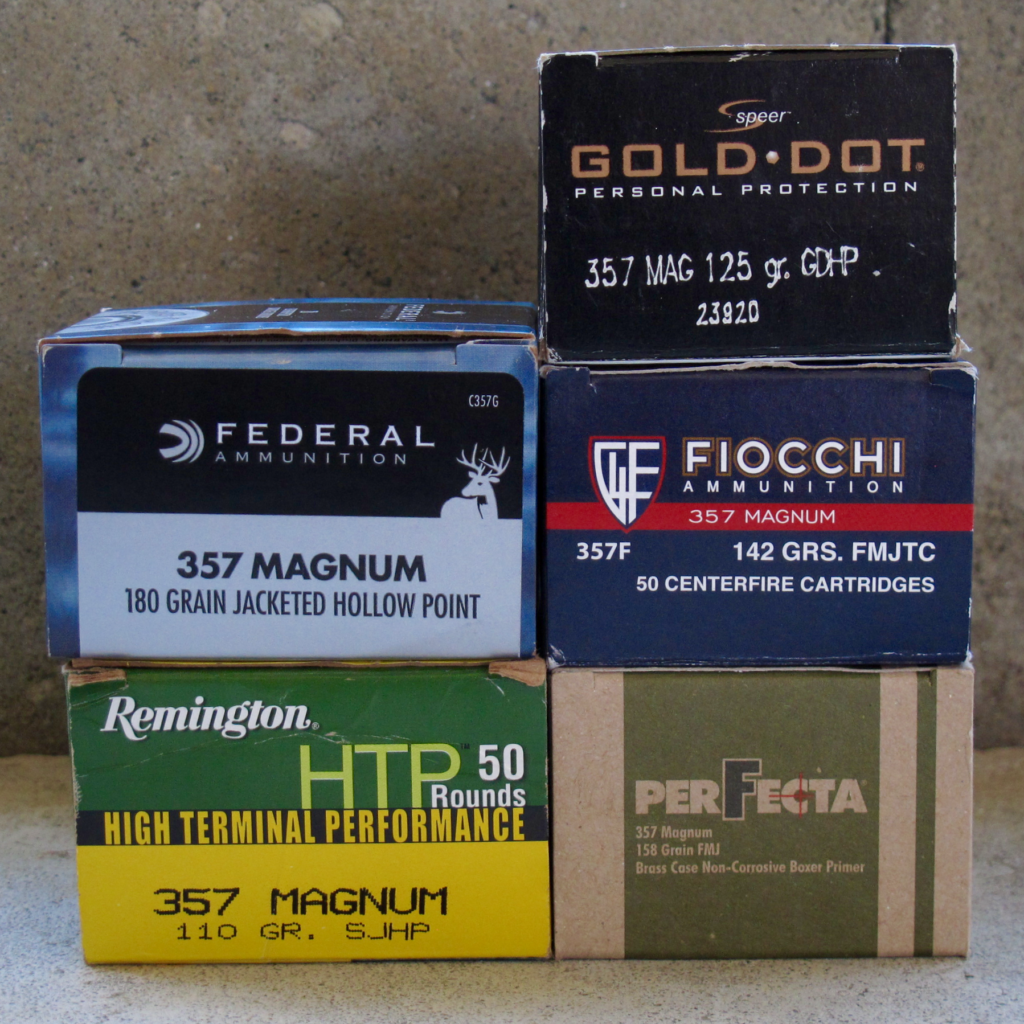
Though the bulk of the ammo I put through this gun was Perfecta 158-grain FMJ, I also fired it with Remington 110-grain SJHP, Speer 125-grain Gold Dot, Fiocchi 142-grain FMJ-TC, and Federal 180-grain JHP. The gun fired everything I threw into it and the grips did an admirable job taming recoil, especially with the heavier Speer loads (the hardest-thumping of the bunch). The only issue I had with the revolver (other than the sight pin backing out) was a failure of a few cases to fully extract. In fairness this was toward the end of an extended range session when the gun was hot. It was also toward the end of my testing and the chambers were filthy. I did find that being aggressive with the ejector rod seemed to solve this issue, and a good cleaning would doubtlessly help in this regard. Still, the chambers feel a bit rougher internally than I am used to.
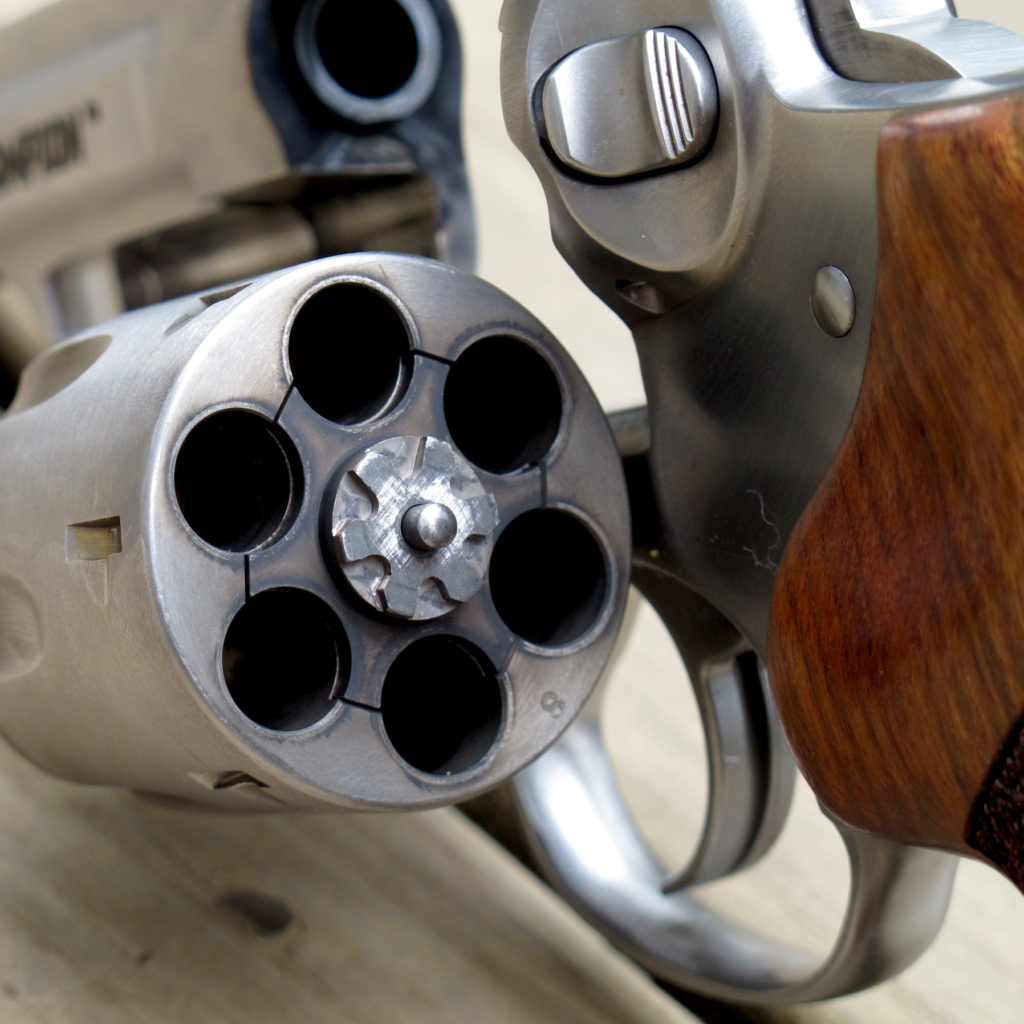
The Bottom Line
I’ve done a lot of nit-picking here, pointing features I like and the ones I don’t particulary care for. On that score you can consider this a connoiseur’s review. To conclude this article, I won’t mince words: the GP100 Match Champion is one of the best current production revolvers money can buy. It is built on a bomb-proof platform. It has some innovative and clever design features. It is rugged and reliable and will likely outlast most of its owners – including those who subject it to heavy use.
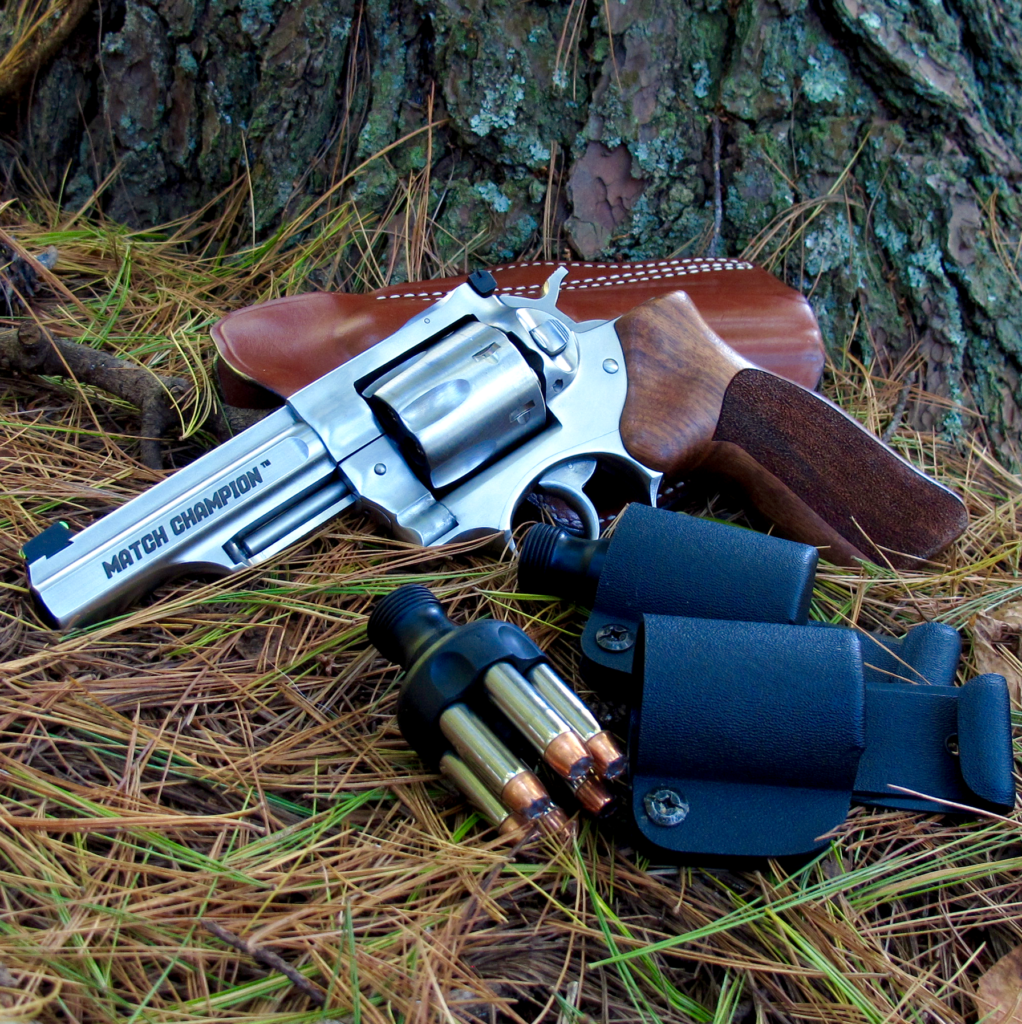
At this point you’re probably asking the questions that I would be asking: “would you buy one” or “would you bet your life on one?” The answer to both is yes. To address the first question, I’ll say that unless something major changes on the revolver market, my next full-sized revolver will be a GP100 in some form or fashion (I would like to hang on to this one, but it’s not in the budget right now).
To address the second question, I did rely (albeit only partially) on the GP100 of some portion of the time I possessed it. During that time I had to make a road trip of around 1,200 miles round-trip. Normally, when embarking on such a trip I throw a larger handgun in the car…just in case. This time instead of my 686 I packed the GP100 in a DeSantis Speed Scabbard, a couple S.L. Variant speedloaders in JOX Loader Pouches, along with 50 rounds of 135-grain Gold Dots. I never doubted my ability to defend myself on that trip for a second. This is hardly a definitive test, but assuming I could fix that rear sight pin, I’d use this gun for anything I’d use any other revolver for.
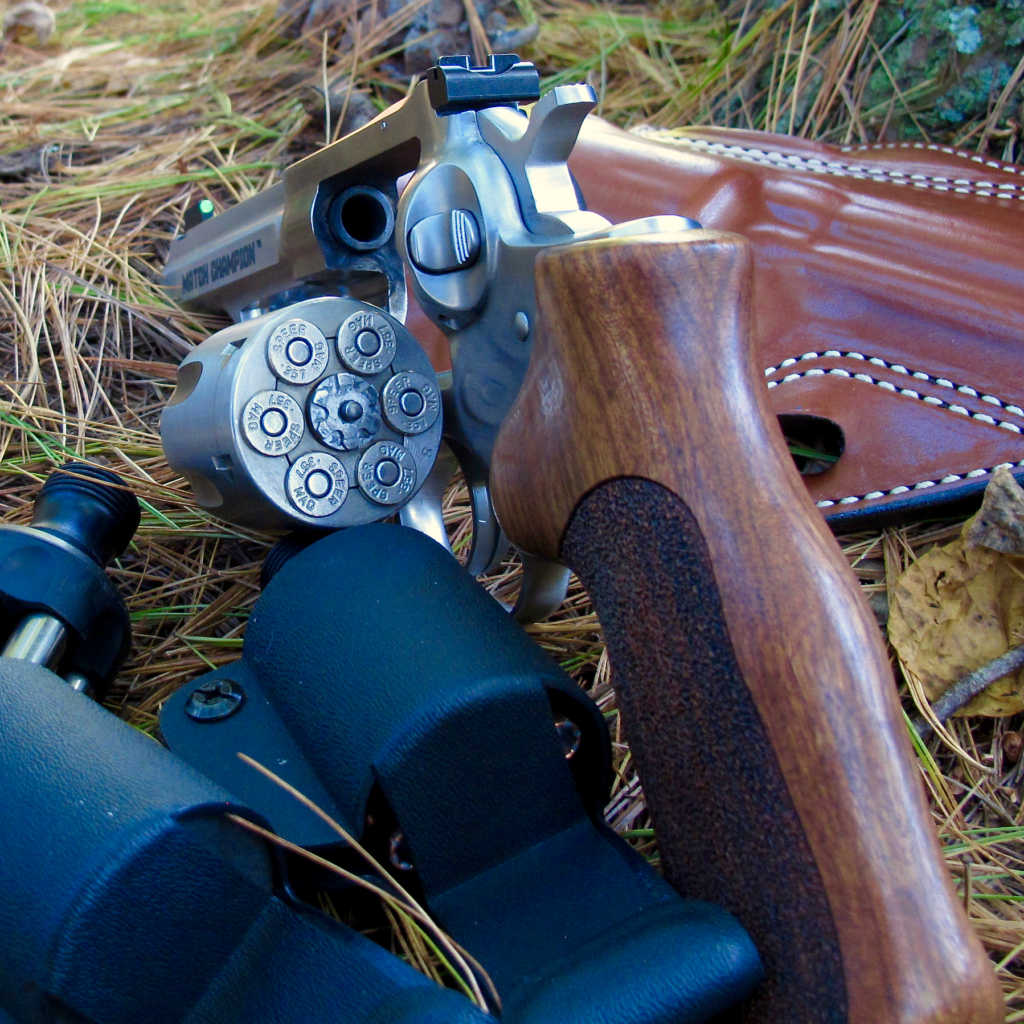
Though the .357 Magnum Match Champion is the gun that Ruger sent, the GP100 comes in a bunch of other variants, too. You can have a GP100 in .22 LR, .357 Magnum, or .44 Special, wearing a blued or stainless finish, with a barrel ranging from three to six inches. You can get it with old-school fixed sights (a rear trench), adjustable sights, or drift-adjustable Novak sights. Ruger revolvers are also nicely supported by the aftermarket and share most L-Frame speedloaders. If you’re looking for a “gun to ride the river with” from today’s offerings, I don’t think you could do any better than the Ruger GP100 – it’s one heck of a good revolver. For more information visit http://www.ruger.com/products/gp100/overview.html.
*Though to be fair, one of these “industry leaders” (who shall remain nameless) did blatantly and, in my estimation embarassingly, copy a manufacturer (who shall also remain nameless) that made its name copying other manufacturers by producing a revolver that chambers shotshells. Discerning who is the real industry leader here can quickly become an exercise in futility.

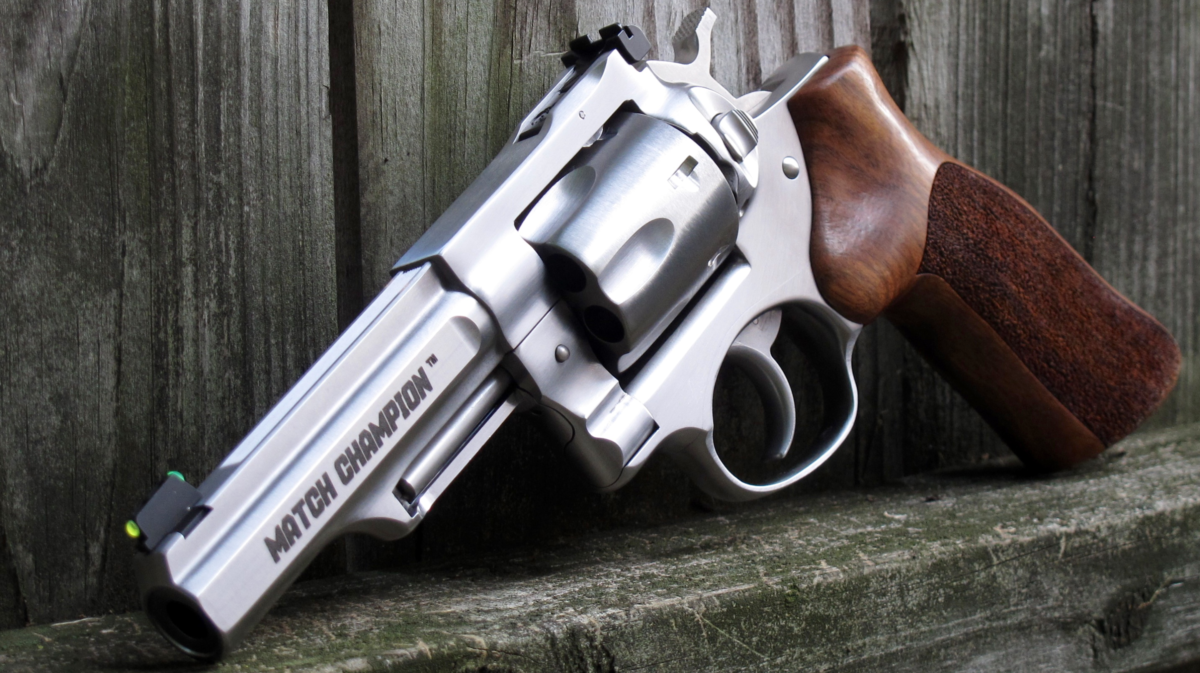
Thank for the review. The Match Champion is probably the gun I would get if I was looking for “Duty Size” revolver and limited to new production (a Six series gun still rates just a touch higher on that list). I just can’t conceal one on my frame very well and I have other guns that are adequate for general purpose use (frankly, my 4″ SP101 checks most of the boxes I would want the GP100 for).
The stocks/grips for this gun are made by Hogue and I notice that Hogue lists the closest equivalent for other guns (the No Finger Groove Checkered grips) as “Made to Order”. What they really mean is just “Not Regularly In Stock”, but it makes wonder if someone couldn’t talk them into doing stippling instead of checkering in order to have equivalent stocks for a Smith.
As a left-handed shooter, I feel even more strongly about the Ruger cylinder release than you do. The angled release on Smiths results in a sharp-ish edge biting into my skin if I use my trigger finger to release the cylinder. With the Ruger, I just push the button and go on with my reload. It hurts less and I get more positive results. When it comes to cylinder releases, I have a definite preference and it goes: Ruger-style, Colt-style, Charter Arms-style, square S&W-style, angled S&W-style with a big gap between the first and second as well as the second and third options.
I did want to mention that the chamfered chambers found on this gun seem to be a standard feature on double-action Ruger revolvers. My SP101’s and my LCRx have the same chamfering shown in the pictures above, and my guns are just plain (not Match Champions, not Wiley Clapp, etc.). It also appears from the pictures on Ruger’s site that the radiused cylinder front is becoming standard on SP101’s and I am curious to see if that becomes the case with the GP100’s as well (my guess is eventually, but they are probably focused on the theoretically more defense-oriented SP101 first).
I also found, at least when comparing SP101’s to J-Frames, that Ruger’s triggers are actually smoother out of the box than S&W’s. That may only apply to the smaller guns, but I noticed way more grit and hitchiness (is that a word?) in the Model 60 triggers I looked at. That may not be the case with the larger Smiths, as I didn’t compare any of those side by side.
All the above, plus the absence of any concerns about a lock, leaves me looking at Ruger revolvers way before I consider Smiths these days.
— Greyson
Greyson,
Good to hear from you – it’s been a while! Thanks for the feedback and additional info. I’m with you – I’m hardly even looking at S&W wheelguns these days, especially after Baker’s review of the updated “Combat Magnum”. I totally agree with you about the triggers, too – though this GP was really rough out of the box, I think it stacks up pretty favorably to most of the modern competition.
Mike and I are going to try to get our hands on a few more Ruger products over the next few months and a SP101 is high on my list of guns to review.
Thanks again,
Justin
Greyson, even though I’m not a southpaw, the S&W cylinder release is rough on me too. I have a scar on my right thumb knuckle from where the release has cut me over the years, and it’s standard practice in this household to break/polish the bottom edge of them (and it still doesn’t fix it entirely). The Ruger latch is a friendlier design in that respect. Same with Colt and Kimber.
I’ve read that a drop of blue Loc-tite on the outside ends of the rear sight pin will keep it from moving while not interfering with the functioning of the sight adjustment. I haven’t tried it, but it seems reasonable. I get that you probably didn’t want to/couldn’t do that on a T&E gun, but if someone owned one, it would be another matter. I do wish Ruger would make that pin fit just a bit more snuggly, though, and eliminate the problem.
— Greyson
I’ll concur with the Locktite droplets. Was really irritating to be checking the sight pin when doing a reload, so Mother necessitated an intervention. The Locktite has worked well the last few years. If/when it fails, I may just peen the ends with a small drift.
As for the cylinder being tapered on ‘newer’ GPs… not on mine, though it isn’t a brand spanking new model (read ‘less than three years’).
S&W 696 triggers… held a Smith in one hand, a GP in the other and made comparisons right out of the box; switched gun to opposite hand with identical results. Smith’s trigger is terrible– but that’s subjective and my opinion.
Oh, yes, love that cylinder release, even more than the Trooper’s. To me, only the Dan Wesson has a more sensible approach to cylinder release, but I tend to find it worrisome (no reason why, mine has never failed); but then, my brother is always telling me I worry too much.
Thanks for this review; I’ve been hoping you’d have a look at this gun.
We have been on the cusp of buying a GP100 for a while. It fits my and my wife’s hands well and she shoots our range’s rental copy, a stock GP100, like a pro. I, on the other hand, have trouble with the all-black front ramp on that one, if I’m shooting at a dark target. The triggers on the MCs we have dry fired have been very nice, though not as nice as our well used, pre-lock S&W 64 4″.
Then I saw a competitor for our dollar, as I wait for Ruger’s March sale at Cabela’s. Ruger sells a Cabelas-only special GP100 with the MC’s high-viz sights and the old-style rosewood-and-rubber grips. It has the full length underlug on the barrel, too, which I prefer on a revolver for home defense for that extra bit of weight. I don’t plan to carry it, so fiber-optics are great for low-light home defense. I also really like the Trijicon tritiums added recently to my 1911, but I would be happy with either setup on a GP100.
What to do? For $100 less than the MC, I’m going to buy a GP100 High Viz in March. I’d lose the smoother trigger and the cylinder chamfering, and with some snap caps and a lot of practice, that trigger will smooth out nicely.
BTW, for those wanting the Match-Champion treatment on a carry gun, the company recently released a SP101 Match Champion.
As Greyson pointed out above, the cylinder chamfering seems to be standard on Ruger revolvers now. I wasn’t aware of this, so you might not lose as much as you think with that Cabela’s GP.
That Cabelas model (1762) is a good looking gun!
Buddy, thanks for such an honest and thorough look at this revolver. I appreciate the fact that you “call ’em as you see ’em” and don’t try to gloss over the things you didn’t like. I think it shows a lot of integrity and I respect the hell out of that. It tells me that RG can be trusted to provide solid information.
For the casual reader who’s become accustomed to all the hyperbole of the popular gun press, where everything is “the ultimate,” or “perfection,” and problems are either excused away or ignored completely, it might seem that you were unhappy with this gun. However, I know the energy and intensity you put into evaluating the gear you stake your life on, and if your final analysis left the Ruger on the top of your list for your next purchase, that says a lot to me.
Question for you: Since Ruger uses a “peg style” frame, do you think those grips could be shortened by somebody with some woodworking skills to achieve the length/fit you wanted?
Mike,
You can probably adjust the fit of the wooden grips quite a bit if you were willing to refinish them (or leave them unfinished), but the length is going to be harder to deal with. The problem is that Hogue uses a stirrup that attaches to the grip frame and a screw goes in through the bottom of the grip. You can kind of see this in Justin’s picture of the gun in the grey box, but it is more obvious if you look at the pictures on Ruger’s site. You can’t really shorten the grip without interfering with the screw setup.
If you were wanting to have a grip kind of like the one on the Match Champion that you could shorten/modify more, your best bet is going to be to make your own from the ground up or shell out the money for some Eagle Classic grips (or maybe find something similar on ebay, but that seems to be hit and miss). Those use a more traditional side screw setup, so you can shorten the grips, round the butt etc. Of course, the Eagle Classics are close enough to Jordan Trooper-style grips that I don’t know if I would go changing things very much.
— Greyson
Ah yes, I forgot all about the Hogue stirrup. Only one of my guns wears Hogues, so the arrangement slipped my mind. I can understand why that wouldn’t work. Thank you Sir!
I think the compact version of the insert grips would probably be the way to go for a shorter stock, but the grip angle would change compared to the MC style.
Mike, I won’t say it can’t be done, but from all appearances, the first answer would be ‘No, can’t be shortened’ (well, maybe 1/8 inch or so). Reason being the ‘peg’ slides into the grip and is then attached via screw in base of grip.
However, there is a tremendous difference between the Sp and GP grips, the SP being smaller and shorter. (A major reason for my not buying one: large carpenter’s hands.) So it may be possible to fit SP grips onto a GP. Again, conjecture since I haven’t tried it.
The GP100 grip stud is larger in every dimension compared to an SP101 grip stud (though the width isn’t too far off). Sadly, you are not going to get an SP101 grip on a GP100 in any cost-effective way. I have considered going the other direction (putting GP100 grips on an SP101), but even then I concluded it would be easier to just make my own grip from scratch. One of these days, I’ll get around to that project…
UncleJSW- I have just experimented with that swap in reverse. After reading your post, I tried sliding the SP grip on one of my GPs’. It slides on just fine, but it’s too short. The peg hits the bottom of the grip while it’s still a good half inch short of the tang. If anyone wants a shorter grip, the practical thing to do is buy one of the Ruger compact grips. Ruger sells them on their on-line store, and you can get them from Altamont.
Nice article. I don’t have a Match Champion, but I have 5 GP100s’ (the first in 1987) which should tell you how I feel about them, so I’ll stick in a few comments. About the rear sight pin, working its’ way out is par for the course. Aside from the Loc-tite solution mentioned earlier, the other standard method is to deform one end of the pin to create a tight fit. Place one end on a piece of metal and hit it with a hammer, or as I’ve often done, crimp it with a pair of vise-grips to mash it so that when driven in it will wedge in the hole. If you shoot a lot, eventually it will loosen, repeat as necessary. It works well enough that so far I haven’t resorted to Loc-tite for the sight pin, although that may come yet.
One thing that I have Loc-tited on all my GP100’s is the cylinder release pivot pin. Below the cylinder release, there is a recess in the frame. If you look inside, you’ll see a small flat headed screw, with a tiny screwdriver slot. Ruger calls it the crane latch pivot. On all of my guns that screw has loosened up sooner or later. On the first one, while shooting one day, the cylinder wouldn’t swing out. Turned out the screw had backed out far enough to disable the release. After that I kept an eye on that screw, and they all loosen up eventually. The last two GPs’ I bought, in 2015 and 2016, were loose within 200 rounds, so they are all
Loc-tited at this point. The SP101 that I bought six weeks ago is currently up to 300 rounds with the screw still tight, we’ll see how long that lasts.
Grips are personal preference items. I’ve got 30 years of muscle memory with the Ruger grip angle (the Six series and the GP rubber/insert grips have the same angle), so I’m not interested in any grip with a different angle. My last two GPs came with Hogue grips, which have what I call the Smith & Wesson angle, closer to 90 degrees. Throwing the gun up the front sight is below the rear notch. I pulled the grips off before firing a shot and replaced them with the rubber/insert grips. I don’t want two options in my memory bank when I bring the gun up instinctively.
Just a few thoughts on my favorite handguns. Again, nice article.
Lee, that’s GREAT info. Thanks for sharing!
You can buy trigger and hammer shims on the web that prevent the hammer/trigger from rubbing as you picture shows. Now expensive and you just try different sizes included in the kit. Type Ruger hammer shims and you will get the webpage
Early morning proof reading failure.
Kits are 8 bucks and are not expensive. Error in my above post
I do that all the time! Thanks for the info, Walt. If I were holding on to this gun I would definitely consider installing one of those kits.
The Match Champion should already have that, though the picture sure makes it look like the hammer shims are missing or the wrong size. From Ruger’s Match Champion page: “Polished and optimized internals, a centering boss on the trigger, and centering shims on the hammer produce a smooth double-action trigger pull and a crisp and consistent let-off.” I hadn’t really thought about that issue because it can be fixed with after market parts easily, but your comment reminded me that Ruger should have already put shims in. Its kind of irritating that they would put in hammer shims but not take the time to ensure they are the right size (or, if they left them out altogether, that is equally irritating since that is some of what you are paying for).
As is probably evident from this discussion, I like Ruger revolvers and think they are at least comparable to current current Smith & Wesson offerings, but it still really bugs me to see a scenario like this. If it were my gun, I would definitely be contacting customer service.
Greyson,
Though the trigger on this gun sucked, I think Ruger revolvers are far superior to current S&W revolvers (especially this ugly thing! https://www.smith-wesson.com/firearms/performance-center-pro-series-model-686-plus-0). Not only did the GP trigger smooth out during my time with it, there is also a lot a gunsmith can do with a Ruger trigger. I’m not kidding when I say that a GP100 will be my next full-sized revolver.
Justin
Agreed (I do like that that PC 686+ has a 5″ barrel, but that is about it).
Frankly, there is a lot that an owner can do to improve a Ruger trigger. The single biggest change that I have done that also happens to be one of the safest for a non-gunsmith is to file off the rough spots on the hammer strut shaft (the part covered by the spring when the gun is assembled). Since the strut is a stamped piece (or at least, it appears that way to me) it has some rough spots along its length. When the spring is compressed by cocking the hammer or pulling the trigger, it essentially bounces along those rough spots. Since this is basically a guide rod for the spring, you don’t have to worry about affecting mating surfaces or engagement angles; as long as the strut is smooth, there is not an issue if you remove a little more material than intended (it still doesn’t take much, so don’t get carried away), and I was amazed how much the double action pull smoothed out.
Ah, the Smith & Wesson Match Champion . . .
Regarding quality control- I lurk but don’t post on the DA revolver board on the Ruger forum. The consensus there seems to be that Ruger quality control has slipped the past few years. They attribute it to the gun sales binge, resulting in Ruger trying to push product out the door as fast as possible. They’ve been sending suggestions to the new CEO to improve QC. On the bright side, they pretty much agree that the customer service is the best.
Personally, the only problem I’ve had on a new Ruger was the SP101 Spurless DAO I bought recently. I swear that every fifth trigger pull was twice as hard as the others. There had to be a burr on the ratchet star somewhere. I couldn’t believe that they would let it leave the factory with a pull like that. Dry firing improved it some, then I took a three cornered fine stone and stoned the ratchet arms. That eliminated the problem, so no harm, no foul. Hopefully, the new CEO will listen to the customers and emphasize quality control.
Lee, we got a chance to see the Ruger Customer Service operation in action as they handled the MkIV recall and it looked like they were doing good work. My personal experience with Ruger Customer Service has been limited to obtaining a replacement cylinder base pin, but they did a great job.
I wonder if the fixed rear sights have the same problem with the pin walking its way out? That might make a difference in which model GP 100 I purchase. The MC can be purchased either way.
I don’t think so. The “standard” GP has a trench milled into the topstrap, and the Wiley Clapp models with Novak sights are dovetailed in.
Justin,
I have 6″ and 3″ Gp 100s and 3″ SP 101.
I prefer the original Letter grips with wood inserts. My 3″ GP came with Hogue rubber that were replaced with the original compact grips.
The regular 4″ and 6″ GPs come with easily changeable front sights.
My 6″ GP and SP both have Wolf spring kits. As you said lots of dry firing helps.
3″ GP is my main carry gun. I prefer fixed sight picture and have painted the front sight. Luckily the 3″ GP and SP 101 show to POA with most loads.
Jim
Regarding the rear sight, Grant Cunningham has written
that the method of pinning the sight and the adjustment
screws for windage and elevation are not the best.
He said the adjustable sighted GP 100s have a tendency
to lose zero after firing. So precise shooting is ruined.
He prefers the fixed sighted GPs.
Adding to my comments about Grant
Cunningham, he did advise replacement
of adjustable sights as a solution. He also
has criticized the standard front sights
which he believes need more refinement
in their finishing.
As for the moving rear sight pin, I have found that a common problem with nearly every adjustable Ruger rear sight I’ve ever owned. Some years ago, (I’m 73 now.) I started easing the pins out about ⅛” & slightly squeezing one end (always the right end when sighting the revolver.) of the pins with a small pair of Vise Grips, kind of flattening it and squeezing it “a little” oval shaped. After which it can be tapped back in flush, & it is tight, and stays in place until it is tapped back out if need be. (Then just tap it out to the right side.)
Jim Keisling,
I remember the problem with the .22 autos. I’d get the pin out
about midway and then slightly bend it; then tap it back into
the receiver. It worked on the .22s; don’t know about if it
would from a .357.
But I like your idea!
I’ve been working with the MC since I bought it, and have changed out the original springs for the mid-range Wolff springs. I also noticed immediately that the hammer shims from the factory just weren’t doing the job, so I replaced them with heavier “TriggerShims Brand” Shim Kit 8 PAK, which I bought from Michigan Center Outdoors – Shively Sales.
Lance C. and Tammy Shively are the owners, & I have no horse in the race here, but they are a GREAT couple to deal with, and great products. Check their stuff out on eBay.
I actually have never found a perfect gun of any kind, that didn’t need just a little tweaking, and most revolvers can benefit greatly & quickly from a little CAREFUL tuning, and it can be quite rewarding in the end !! I just love revolvers !!!
Jim
Thanks for the review, Justin. The Match Champion had me excited as soon as it was announced. I’m glad it looks like a winner.
I was inching towards picking one up until I saw that Ruger was chambering Redhawks in .357.
An 8 rd .357 magnum? Yes, please!
I have no intention of concealed carry with a big wheel gun, so a little extra weight for a couple extra rounds is just gravy.
The model 5059 with a 4.2″ barrel looks perfect.
If you get a chance to check one out (any .357 Redhawk), I would love to read what you think.
With cold weather still hanging on here, I have not been able to get to the range as much as I would like to. But, I am becoming more & more impressed with the M.C. !! I put the older Letts wood insert grips on it, & have become confident enough in it to use it for CCW on several occasions. As I am no small person, I have no problem with the size of the revolver, & every confidence it will perform admirably if called upon for that purpose !! I love it, & it has been 100% reliable with the “Wolfe Spring Kit & Shim Kit” installed for several hundred Winchester .357 rounds & a few hundred reloaded .38 Spl.+P rounds !
I enjyed your review of the Match Champion!
I have one, and I am beginning to like it a lot. I don’t really like the wooden grips, so I replaced them with the olds-style rubber-with- insert grips, which feel much better.
The Wolff spring pack I bought reduced the pull to very nice, and whilst it was apart, I did some minor polishing, which smoothed things nicely. I have the same problem with the hammer and left edge of the frame rubbing, so I may buy the Triggershims pack. I have had several very good results with Lance and Triggershims, and his products seem first-class.
One problem I have with my MC, is that the hammer pivot pin will work itself out when being fired. I have replaced the pin, but the problem seems to continue. The grips hold it in, so it is not a large problem….just an irritant, and I don’t know if is a common problem. The rep at Ruger who sent me the new hammer pivot said he didn’t think it should do that. Hmmm…maybe blue Locktite, which was mentioned as a solution for a wandering rear sight pin?
I don’t wish to send my revolver back to Ruger, because I’d have to disassemble it, replace the springs, and do it all over again when I got it back. Modular, perhaps, but it is a real woollybugger to get apart… my two hands trying to get the trigger assenbly out, with my wife hammering on the mainspring housing…GENTLY, WIFE!!! Very tight, which is good.
Haha! You’re a brave man, Sir! Not sure I would ask my wife to hammer on something I was holding in my mitts!
I have a Ruger Match Champion and like it a lot. I modified the Hogue grip to fit my hand better. That said I have absolutely no problem carrying it concealed. Im a big fella and wear my shirt tails out.
After a long, cold/wet winter, yesterday I took my GP 100 to the range. Good day! I found out the Speer 135 gr. 357 magnum loads shoot to the same POI as my ancient IPSC 150-158 gr cast loads, and the recoil is not all that much more. Very comfortable to shoot! I loaded alternate IPSC and Speer 135 gr. Magnum rounds just to see, and was pleasantly surprised! Recoil and accuracy was nearly the same at 18-25 yards. In the True Spirit of Never Leaving Well-Enough Alone, I am going to increase my IPSC load to ~6.0 gr/ Unique. Maybe it will make them “more equal” or something. I plan to buy more of that 357 ammo. It’s good stuff!